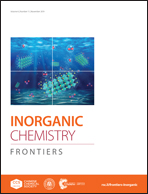In situ growth of copper(ii) phthalocyanine-sensitized electrospun CeO2/Bi2MoO6 nanofibers: a highly efficient photoelectrocatalyst towards degradation of tetracycline†
Abstract
We present a controllable synthesis of one-dimensional CeO2/Bi2MoO6 nanofibers sensitized with 2,9,16,23-tetranitrocopper(II) phthalocyanine (TNCuPc) via a facile two-step electrospinning-solvothermal strategy, where TNCuPc granules grow uniformly in situ on the surface of CeO2/Bi2MoO6 nanofibers. Electron microscopy and associated spectroscopy are adopted for probing the material morphology, microstructure, and optical and photoelectrochemical properties. The as-obtained one-dimensional TNCuPc/CeO2/Bi2MoO6 photocatalysts with rapid separation efficiency of photogenerated carriers and wide range of solar light photoresponse possess remarkable photocatalytic activity, excellent recyclability and long-term stability towards degradation of tetracycline (TC) under simulated sunlight irradiation. In the process of photocatalysis, the intermediates and possible photodegradation pathways of TC are explored in detail. Such high performance could be attributed to the sensitization effect of TNCuPc and synergetic effect among TNCuPc, CeO2 and Bi2MoO6 as well. This work could afford a new approach to construct heterojunction photocatalysts to further boost the functionality in wastewater treatment and remediation.



 Please wait while we load your content...
Please wait while we load your content...